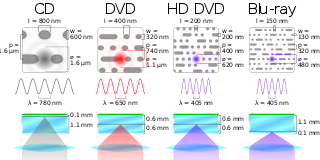Related Research Articles

In computing and optical disc recording technologies, an optical disc (OD) is a flat, usually circular disc that encodes binary data (bits) in the form of pits and lands on a special material, often aluminum, on one of its flat surfaces. Its main uses are physical offline data distribution and long-term archival. Changes from pit to land or from land to pit correspond to a binary value of 1; while no change, regardless of whether in a land or a pit area, corresponds to a binary value of 0.

A DVD player is a device that plays DVDs produced under both the DVD-Video and DVD-Audio technical standards, two different and incompatible standards. Some DVD players will also play audio CDs. DVD players are connected to a television to watch the DVD content, which could be a movie, a recorded TV show, or other content.
A format war is a competition between similar but mutually incompatible technical standards that compete for the same market, such as for data storage devices and recording formats for electronic media. It is often characterized by political and financial influence on content publishers by the developers of the technologies. Developing companies may be characterized as engaging in a format war if they actively oppose or avoid interoperable open-industry technical standards in favor of their own.
Versatile Multilayer Disc was a high-capacity red-laser optical disc technology designed by New Medium Enterprises, Inc. VMD was intended to compete with the blue-laser Blu-ray Disc and HD DVD formats and had an initial capacity of up to 30GB per side. At a physical level, VMD is identical to DVD, but with the possibility of using more layers.

The Blu-ray Disc Association (BDA) is the industry consortium that develops and licenses Blu-ray Disc technology and is responsible for establishing format standards and promoting business opportunities for Blu-ray Disc. The BDA is divided into three levels of membership: the board of directors, contributors, and general members.

Windows Media High Definition Video is the marketing name for high definition videos encoded using Microsoft Windows Media Video 9 codecs. These low-complexity codecs make it possible to watch high definition movies in 1280×720 (720p) or 1920×1080 (1080p) resolutions on many modern personal computers running Microsoft Windows XP or Windows Vista, although the hardware requirements are steep. Microsoft's Xbox 360 and Sony's PlayStation 3 video game consoles can also play WMV HD.
AVCHD is a file-based format for the digital recording and playback of high-definition video. It is H.264 and Dolby AC-3 packaged into the MPEG transport stream, with a set of constraints designed around the camcorders.
The first attempt at producing pre-recorded HDTV media was a scarce Japanese analog MUSE-encoded laser disc which is no longer produced.

This article compares the technical specifications of multiple high-definition formats, including HD DVD and Blu-ray Disc; two mutually incompatible, high-definition optical disc formats that, beginning in 2006, attempted to improve upon and eventually replace the DVD standard. The two formats remained in a format war until February 19, 2008, when Toshiba, HD DVD's creator, announced plans to cease development, manufacturing and marketing of HD DVD players and recorders.

The DVD is a digital optical disc data storage format invented and developed in 1995 and released in late 1996. Currently allowing up to 17.08 GB of storage, the medium can store any kind of digital data and was widely used for software and other computer files as well as video programs watched using DVD players. DVDs offer higher storage capacity than compact discs while having the same dimensions.

The Blu-ray Disc (BD), often known simply as Blu-ray, is a digital optical disc storage format. It is designed to supersede the DVD format, and capable of storing several hours of high-definition video. The main application of Blu-ray is as a medium for video material such as feature films and for the physical distribution of video games for the PlayStation 3, PlayStation 4, PlayStation 5, Xbox One, and Xbox Series X. The name "Blu-ray" refers to the blue laser used to read the disc, which allows information to be stored at a greater density than is possible with the longer-wavelength red laser used for DVDs.

HD DVD is a discontinued high-density optical disc format for storing data and playback of high-definition video. Supported principally by Toshiba, HD DVD was envisioned to be the successor to the standard DVD format.
As of 2021, multiple consumer-oriented, optical-disk media formats are or were available:
Although research into optical data storage has been ongoing for many decades, the first popular system was the Compact Disc, introduced in 1982, adapted from audio (CD-DA) to data storage with the 1985 Yellow Book, and re-adapted as the first mass market optical storage medium with CD-R and CD-RW in 1988. Compact Disc is still the de facto standard for audio recordings, although its place for other multimedia recordings and optical data storage has largely been superseded by DVD.
China Blue High-Definition is a high definition optical disc format announced in September 2007 by the Optical Memory National Engineering Research Center (OMNERC) of Tsinghua University in China.

The high-definition optical disc format war was between the Blu-ray and HD DVD optical disc standards for storing high-definition video and audio; it took place between 2006 and 2008 and was won by Blu-ray Disc.
.m2ts is a filename extension used for the Blu-ray disc Audio-Video (BDAV) MPEG-2 Transport Stream (M2TS) container file format. It is used for multiplexing audio, video and other streams. It is based on the MPEG-2 transport stream container. This container format is commonly used for high definition video on Blu-ray Disc and AVCHD.

DVD-Video is a consumer video format used to store digital video on DVD discs. DVD-Video was the dominant consumer home video format in Asia, North America, Europe, and Australia in the 2000s until it was supplanted by the high-definition Blu-ray Disc. Discs using the DVD-Video specification require a DVD drive and an MPEG-2 decoder. Commercial DVD movies are encoded using a combination MPEG-2 compressed video and audio of varying formats. Typically, the data rate for DVD movies ranges from 3 to 9.5 Mbit/s, and the bit rate is usually adaptive. DVD-Video was first available in Japan on November 1, 1996, followed by a release on March 24, 1997 in the United States—to line up with the 69th Academy Awards that same day.
Sony Digital Audio Disc Corporation is a manufacturer of CDs, DVDs, UMDs, and Blu-ray Discs. The company has many plants worldwide. Although it primarily services Sony Music Entertainment-owned record labels, Sony Pictures Home Entertainment, and Sony Interactive Entertainment, it also manufactures discs for other labels, home entertainment distributors, and video game publishers.